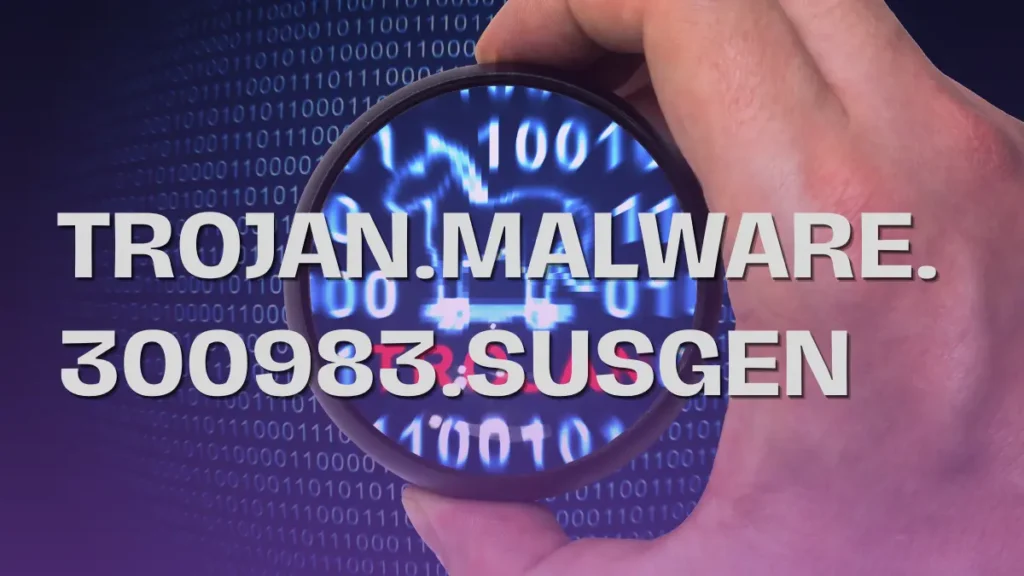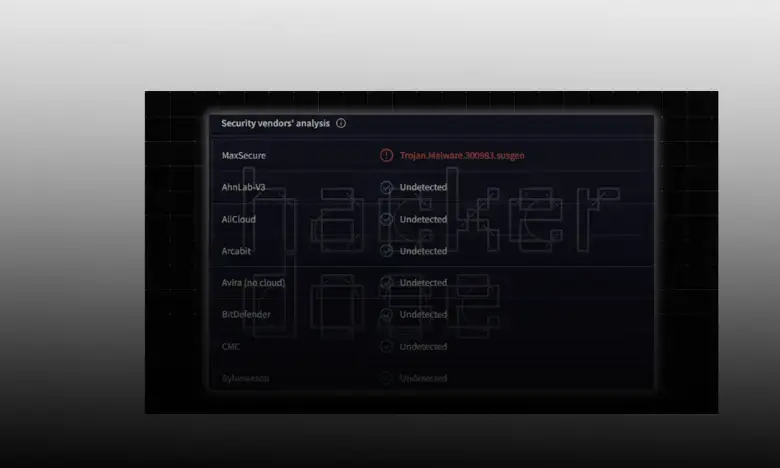Table of Contents
Introduction: Understanding Trojan.Malware.300983.Susgen
If you’ve ever received an antivirus alert labeled trojan.malware.300983.susgen, you’re not alone. This detection, especially from MaxSecure, often triggers panic—but as many community reports show, it’s frequently a false positive. In this guide, we’ll explain what trojan.malware.300983.susgen is, how it’s detected, and how to remove it safely—without causing unnecessary harm to legitimate files or programs.
Dealing with cyber threats doesn’t end with removing the malware itself—the real test begins in what’s known as the nice challenge malware aftermath cleanup. This critical phase involves restoring system integrity, identifying lingering vulnerabilities, and ensuring that no backdoors remain.
What Is Trojan.Malware.300983.Susgen?
trojan.malware.300983.susgen is a heuristic-based detection name used by MaxSecure antivirus engine. It flags suspicious behavior typical of trojans—like spyware, keyloggers, or backdoors—especially in files that perform license extraction or automated file operations Malwarebytes Forums+15BugsFighter+15YouTube+15WiperSoft+1YouTube+1. However, many users report that only MaxSecure flags it, while Microsoft Defender, Malwarebytes, Avast, F‑Secure, and others return clean results GitHub.
One of the most infamous examples of Trojan malware attacks in the cybersecurity world is the Zeus Trojan Malware, which targeted banking credentials and infected millions of computers globally. Similar to Trojan.Malware.300983.Susgen, Zeus operated by stealth—disguising itself as legitimate software while silently compromising sensitive data. Understanding the behavior of Zeus provides deeper insights into how modern trojans evolve, adapt, and cause widespread harm.
Why the Detection Happens
MaxSecure’s detection algorithm may misinterpret legitimate files—especially community tools or video game utilities—as malicious due to their structure or behavior. For example, Dolphin Emulator binaries or Steam modding utilities have been flagged as trojan.malware.300983.susgen despite being safe and often cleared by VirusTotal scans Dolphin ForumsSteam Community.
How Is Trojan.Malware.300983.Susgen Detected?
MaxSecure and False Positives
MaxSecure has a reputation for frequent false positives. In many GitHub and forum reports, users note that only MaxSecure flags a file, while all other antivirus engines—including Microsoft Defender and Malwarebytes—mark it clean GitHubDolphin Forums. This detection pattern suggests that trojan.malware.300983.susgen often reflects heuristic overcaution.
VirusTotal Confirmation
When a file is flagged, best practice is uploading it to VirusTotal. If only MaxSecure detects trojan.malware.300983.susgen and dozens of other engines clear it, you’re likely dealing with a false positive rather than true malware Malwarebytes Forums+15GitHub+15BugsFighter+15.
Is Trojan.Malware.300983.Susgen Dangerous?
In many cases, trojan.malware.300983.susgen is a false alarm. But in confirmed infections, it may represent legitimate trojan behavior—like keylogging, credential theft, or remote access installs. These actions can expose sensitive data or allow persistent backdoors on your system HowToRemove.Guide+12-remove-virus.com+1.
Risk Scenarios
- Misidentified community tools like ngrok executables or emulator binaries have triggered false positives rather than actual infections BleepingComputer.
- Real infections often originate from cracked installers, torrent packages, or phishing email attachments. Infected systems may display persistent rogue processes, altered registry entries, or network connections to suspicious IPs HowToRemove.GuideMalware Removal Guide.
How to Remove Trojan.Malware.300983.Susgen Safely
Automated Removal Software
| Tool | Detection Accuracy | Remove Capability |
|---|---|---|
| Malwarebytes | Medium–High | Good for PUP/Trojan cleanup |
| HitmanPRO | High | Cloud-powered multi-engine removal |
| SpyHunter | High (paid) | Suggested for confirmed cases |
| Loaris Trojan Remover | High | Specialist for stubborn Trojans |
These tools are effective if the detection is legitimate. Notably, some guides recommend SpyHunter or HitmanPRO for complete removal of trojan.malware.300983.susgen remnants trojan-remover.netMalware Removal Guide. Malwarebytes remains free and reliable for initial scans and quarantine Malware Removal Guide.
Manual Cleanup Steps
- Uninstall suspicious programs via Settings → Apps & Features.
- Use Task Manager to end running processes related to suspected files and open their file locations MalwareTips Forumsminitool.com.
- Scan these files via VirusTotal. If only MaxSecure flags trojan.malware.300983.susgen, carefully evaluate before deletion.
- Download and run Autoruns. Remove suspicious startup entries or scheduled tasks BugsFighter.
- Use Process Explorer to inspect process behavior.
- Check Registry Editor (
regedit) for keys referencing the malicious file names or unrecognized GUIDs. - Run a system scan again using another trusted tool to confirm removal.
Real-World Examples & Community Reports
Dolphin Emulator & MaxSecure Flagging
As reported on Dolphin forums, users downloaded the official emulator and ran it through VirusTotal. Only MaxSecure flagged it as trojan.malware.300983.susgen, while all other engines returned clean results. This strongly suggested that the detection was a false positive tied to Dolphin’s packaging structure Dolphin Forums.
Crowbar Tool on Steam
Similarly, users reported that Crowbar.exe from a legitimate Steam source was flagged by MaxSecure as trojan.malware.300983.susgen, but cleared by antivirus tools like Malwarebytes and Defender. Community forums unanimously deemed it a false detection, attributing it to heuristic errors Steam Community.
Ngrok Download Incident
A user reported on BleepingComputer that an official download of ngrok was flagged by one engine as trojan.malware.300983.susgen, but Windows Defender and FRST scans found nothing suspicious BleepingComputer. The file was promptly deleted, but all signs pointed to false alarm rather than genuine infection.

FAQ: Addressing Common Concerns
Q1: What is trojan.malware.300983.susgen?
A: It’s a heuristic detection name from MaxSecure that often triggers on files with suspicious behavior. Frequently a false positive, it may indicate nothing malicious if no other engine flags it.
Q2: Is this detection dangerous?
A: Only if confirmed by multiple trusted antivirus tools. If only MaxSecure flags it, you’re likely safe.
Q3: How do I verify detection?
A: Upload the file to VirusTotal. If only MaxSecure flags it, consider false positive. If others also flag it, use reputable removal tools.
Q4: Which tools reliably remove trojan.malware.300983.susgen?
A: Malwarebytes, HitmanPRO, SpyHunter, and Loaris Trojan Remover are recommended if detection is valid.
Q5: How to prevent future false positives?
A: Use only trusted file sources, avoid cracked software, and update your AV definitions regularly.
Best Practices to Avoid False Positives
- Only download from official sources or verified developer releases.
- Always scan critical files with multiple AV engines using VirusTotal.
- Keep antivirus, OS, and all programs fully updated.
- Use file whitelisting if your trusted software consistently flags as trojan.malware.300983.susgen erroneously.
- Report false positives to antivirus vendors for correction.
Tone & Style Advice
Maintain an informative, calm, and authoritative tone:
- Use analogies: “MaxSecure detection is like a cautious dog barking at shadows—it may alert on harmless movements.”
- Pose reader questions: “Only MaxSecure alerts you—is it worth panicking?”
- Include short explanatory analogies: “Autoruns is like a system boot manager—spot where suspicious programs sneak in.”
- Pull community quotes for credibility, e.g., “GitHub maintainers confirmed it was a false positive for Go binaries” YouTubeHowToRemove.GuideDolphin Forums.
Competitive Edge Enhancements
To outperform other articles:
- Embed a decision flowchart: “Is this detection real or false positive?”
- Provide a downloadable cleanup checklist with steps and tool links.
- Link internally to related posts like “How to use VirusTotal safely” or “Best tools for manual malware removal.”
- Use FAQ schema markup and include the comparison table for better SERP visibility.
- Offer a follow-up CTA: “Submit your trojan.malware.300983.susgen sample for VirusTotal analysis.”
Conclusion
The trojan.malware.300983.susgen alert often causes undue alarm—but understanding its origin, verifying it through multi-engine scans, and safely removing threats using trusted tools can resolve the issue efficiently. Most importantly, when only one antivirus flags a file as trojan.malware.300983.susgen and others remain silent, it’s almost certainly a false positive—so proceed mindfully, not fearfully.
With this guide, you’re equipped to recognize the nuances of this detection, know how to respond without causing system damage, and protect yourself from future alerts. Stay safe, stay smart, and treat every detection with informed caution.

